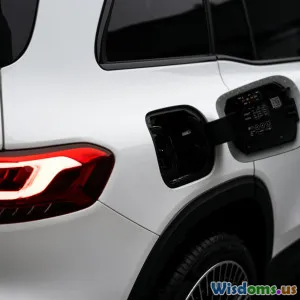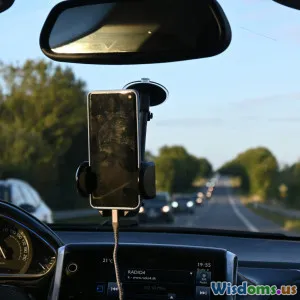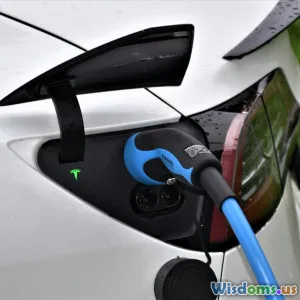
Common Myths About Connected Vehicles Debunked
10 min read Debunking common misconceptions about connected vehicles to reveal the true potential and safety behind this revolutionary technology. (0 Reviews)
Common Myths About Connected Vehicles Debunked
In today’s rapidly evolving automotive landscape, connected vehicles are hailed as the future of transportation. Their ability to communicate with other vehicles, infrastructure, and the internet promises enhanced safety, efficiency, and convenience. Yet, despite broad adoption and technological advancements, many myths cloud public perception about connected vehicles. These misconceptions often lead to hesitation and skepticism. This article aims to clear up confusion by debunking the most prevalent myths surrounding connected vehicles, supported with real-world examples, research, and expert opinion.
Introduction: The Hype and Hesitation around Connected Vehicles
Connected vehicles, also known as smart cars or Internet of Vehicles (IoV), use a combination of sensors, wireless connectivity, and cloud-based services to share data in real-time. They enable key features like adaptive cruise control, collision avoidance, traffic alerts, and over-the-air software updates. According to the International Data Corporation (IDC), by 2025, over 380 million connected cars will be on the road worldwide.
However, perception often does not keep pace with the technology’s capabilities. Fear of hacking, concerns about privacy, assumptions of unaffordability, worries about job losses, and misunderstandings about operational functionality frequently overshadow genuine benefits. This disconnect slows down the adoption curve and impedes societal advancement.
Myth 1: Connected Vehicles Are Most Vulnerable to Cyberattacks
Myth: Because connected vehicles continuously exchange data, they are extremely vulnerable to cyberattacks and hacking.
Reality: While connected vehicles do present new cybersecurity challenges, manufacturers and tech companies implement multiple layers of security, often exceeding traditional vehicle standards.
Understanding Vehicle Cybersecurity Measures
Automotive experts follow rigorous standards like ISO/SAE 21434 for cybersecurity risk management. Encryption, intrusion detection systems, secure booting, and over-the-air (OTA) security patches are standard. Companies like Tesla, BMW, and Ford actively patch vulnerabilities post-release, demonstrating responsible security maintenance akin to smartphone manufacturers.
Real-World Insight
A notable incident in 2015 showed white-hat hackers remotely commandeering a Jeep Cherokee via its infotainment system. This incident was swiftly addressed by FCA (Fiat Chrysler Automobiles) who rolled out a security update within days over cellular networks—showcasing how connected vehicles can respond faster than conventional recalls.
Cybersecurity remains a continuous effort, but today’s connected cars are no less secure than many other IoT devices consumers use daily.
Myth 2: Connected Vehicles Will Cause Massive Job Losses
Myth: The rise of connected, autonomous vehicles will lead to widespread unemployment, particularly affecting drivers, mechanics, and transport workers.
Reality: While automation introduces shifts in labor demands, it simultaneously creates new job categories and improves overall safety—potentially reducing crashes most caused by human error.
Shifting Job Landscape
According to McKinsey Global Institute, automation could transform up to 15% of worldwide jobs but also creates opportunities in vehicle technology development, data analysis, cybersecurity, fleet management, and urban planning.
Moreover, roles in automotive maintenance are evolving rather than disappearing. Connected vehicles require sophisticated diagnostics, software updates, and hardware servicing, demanding higher technical skills rather than fewer jobs.
Safety and Economic Benefits
The National Highway Traffic Safety Administration (NHTSA) estimates that 94% of serious crashes result from human error. Connected vehicles reduce errors through proactive communication and assistive interventions, potentially saving thousands of lives and billions in economic costs annually.
Myth 3: Only Expensive Luxury Vehicles Are Connected
Myth: Connected vehicle technology is reserved mostly for premium or luxury cars, making it inaccessible for most drivers.
Reality: The feature gap is rapidly closing as connected technologies become affordable and standardized.
Market Trends and Examples
Today, manufacturers including Toyota, Hyundai, and Ford integrate connected vehicle tech like emergency braking, lane-keep assist, and real-time traffic updates into entry-level or mid-range vehicles. According to a 2023 study by Frost & Sullivan, the average cost to implement basic vehicle-to-everything (V2X) connectivity dropped by 40% over the past five years.
Government incentives and infrastructure investments further accelerate availability. For example, the European Union has mandated all new vehicles be equipped with Advanced Driver-Assistance Systems (ADAS), which rely partly on connected vehicle technology, by 2024.
Myth 4: Connected Vehicles Compromise User Privacy
Myth: Because connected vehicles transmit data, personal privacy is inevitably compromised.
Reality: Although connected vehicles collect data, strong privacy protocols are embedded to comply with regulations and protect user information.
Data Governance and Compliance
Automakers comply with data protection laws such as the General Data Protection Regulation (GDPR) in Europe and the California Consumer Privacy Act (CCPA) in the US, ensuring transparency about what data is collected and how it is used.
Manufacturers typically anonymize data used for traffic analysis and only share aggregated information rather than individual driving profiles. Features like remote control, location tracking, or vehicle diagnostics require explicit user consent.
Practical Implications
Privacy experts note that connected vehicles do not inherently lead to surveillance but require responsible safeguarding. Industry groups and watchdog organizations are actively engaged in creating standards for ethical data practices.
Myth 5: Connected Vehicles Operate Fully Autonomously Without Human Control
Myth: Connected vehicles function completely independently and require no input or oversight from drivers.
Reality: Most connected vehicles today provide driver assistance features designed to augment—not replace—human drivers.
Driver Assistance vs. Fully Autonomous
Level 1 to Level 3 autonomous vehicles provide varying levels of assistance (e.g., adaptive cruise control, lane centering) but expect human drivers to monitor the environment and intervene if necessary.
For context, as defined by SAE International:
- Level 0: No automation
- Level 1: Driver assistance (e.g., cruise control)
- Level 2: Partial automation (monitoring both steering and acceleration)
- Level 3: Conditional automation (driver can disengage temporarily)
- Level 4: High automation (no driver attention needed under specific conditions)
- Level 5: Full automation (no driver interaction at all)
Currently, most commercially available connected vehicles are Level 2 or 3. Tesla’s Full Self-Driving (FSD) Beta is an example of Level 2/3 with human oversight as mandatory.
Safety Implications
Connected vehicle tech works in synergy with human control to enhance safety. Regulatory agencies actively monitor deployments to ensure readiness and prevent premature claims.
Conclusion: Embracing Connected Vehicles with Informed Understanding
Connected vehicles represent a transformative trend that integrates technology and transport for safer roads, smarter traffic management, and enhanced user convenience. However, myths and misconceptions misrepresent the realities. As explored:
- Cybersecurity is managed with proactive, evolving defenses.
- Job shifts due to automation focus on upgrading skill sets, not wholesale unemployment.
- Pricing is democratizing technology access beyond luxury vehicles.
- Privacy concerns are addressed through compliance and ethical data practices.
- Connected vehicles complement rather than replace human drivers today.
Public education, transparent communication from manufacturers, and supportive policies play crucial roles in correcting misunderstandings. Embracing connected vehicle technology informed by facts will accelerate a safer, more efficient transportation future for everyone.
References:
- NHTSA, "Critical Reasons for Crashes," 2015
- McKinsey Global Institute, "Jobs Lost, Jobs Gained," 2017
- IDC, "Worldwide Connected Car Forecast," 2023
- Frost & Sullivan, "Connected Vehicle Market Analysis," 2023
- ISO/SAE 21434:2021, Road Vehicles – Cybersecurity Engineering
This article invites readers to explore connected vehicles with an open, informed perspective, laying a foundation for smarter choices behind the wheel and in automotive innovation.
Rate the Post
User Reviews
Other posts in Autonomous Vehicles
Popular Posts















